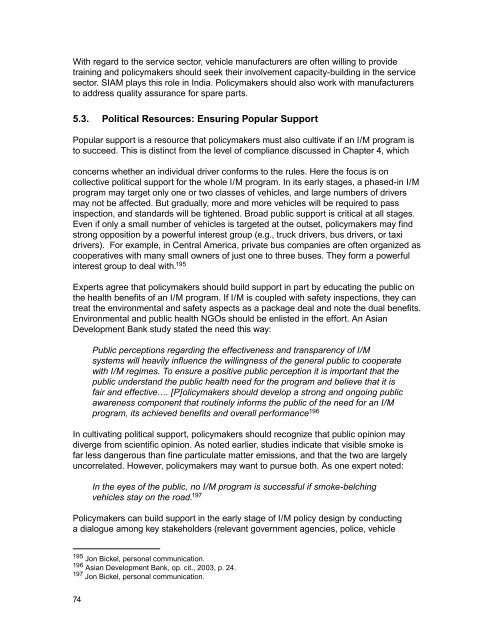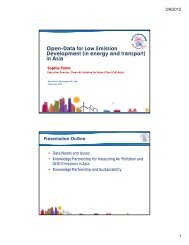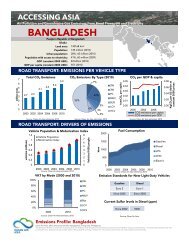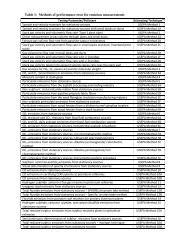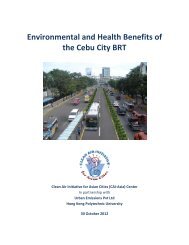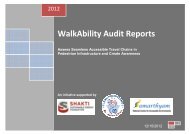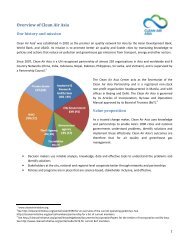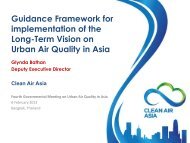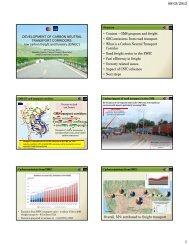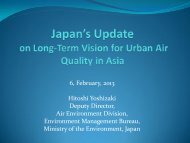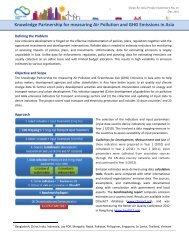International Experience and Best Practices - Clean Air Initiative
International Experience and Best Practices - Clean Air Initiative
International Experience and Best Practices - Clean Air Initiative
Create successful ePaper yourself
Turn your PDF publications into a flip-book with our unique Google optimized e-Paper software.
With regard to the service sector, vehicle manufacturers are often willing to provide<br />
training <strong>and</strong> policymakers should seek their involvement capacity-building in the service<br />
sector. SIAM plays this role in India. Policymakers should also work with manufacturers<br />
to address quality assurance for spare parts.<br />
5.3. Political Resources: Ensuring Popular Support<br />
Popular support is a resource that policymakers must also cultivate if an I/M program is<br />
to succeed. This is distinct from the level of compliance discussed in Chapter 4, which<br />
concerns whether an individual driver conforms to the rules. Here the focus is on<br />
collective political support for the whole I/M program. In its early stages, a phased-in I/M<br />
program may target only one or two classes of vehicles, <strong>and</strong> large numbers of drivers<br />
may not be affected. But gradually, more <strong>and</strong> more vehicles will be required to pass<br />
inspection, <strong>and</strong> st<strong>and</strong>ards will be tightened. Broad public support is critical at all stages.<br />
Even if only a small number of vehicles is targeted at the outset, policymakers may find<br />
strong opposition by a powerful interest group (e.g., truck drivers, bus drivers, or taxi<br />
drivers). For example, in Central America, private bus companies are often organized as<br />
cooperatives with many small owners of just one to three buses. They form a powerful<br />
interest group to deal with. 195<br />
Experts agree that policymakers should build support in part by educating the public on<br />
the health benefits of an I/M program. If I/M is coupled with safety inspections, they can<br />
treat the environmental <strong>and</strong> safety aspects as a package deal <strong>and</strong> note the dual benefits.<br />
Environmental <strong>and</strong> public health NGOs should be enlisted in the effort. An Asian<br />
Development Bank study stated the need this way:<br />
74<br />
Public perceptions regarding the effectiveness <strong>and</strong> transparency of I/M<br />
systems will heavily influence the willingness of the general public to cooperate<br />
with I/M regimes. To ensure a positive public perception it is important that the<br />
public underst<strong>and</strong> the public health need for the program <strong>and</strong> believe that it is<br />
fair <strong>and</strong> effective…. [P]olicymakers should develop a strong <strong>and</strong> ongoing public<br />
awareness component that routinely informs the public of the need for an I/M<br />
program, its achieved benefits <strong>and</strong> overall performance 196<br />
In cultivating political support, policymakers should recognize that public opinion may<br />
diverge from scientific opinion. As noted earlier, studies indicate that visible smoke is<br />
far less dangerous than fine particulate matter emissions, <strong>and</strong> that the two are largely<br />
uncorrelated. However, policymakers may want to pursue both. As one expert noted:<br />
In the eyes of the public, no I/M program is successful if smoke-belching<br />
vehicles stay on the road. 197<br />
Policymakers can build support in the early stage of I/M policy design by conducting<br />
a dialogue among key stakeholders (relevant government agencies, police, vehicle<br />
195 Jon Bickel, personal communication.<br />
196 Asian Development Bank, op. cit., 2003, p. 24.<br />
197 Jon Bickel, personal communication.


